
A revolver is a repeating handgun that has at least one barrel and uses a revolving cylinder containing multiple chambers for firing. Because most revolver models hold up to six cartridges, before needing to be reloaded, revolvers are commonly called six shooters or sixguns. Due to their rotating cylinder mechanism, they may also be called wheel guns.

Smith & Wesson Brands, Inc. (S&W) is an American firearm manufacturer headquartered in Maryville, Tennessee, United States.

The .40 S&W (10.2×22mm) is a rimless pistol cartridge developed jointly by American firearms manufacturers Smith & Wesson and Winchester in 1990. The .40 S&W was developed as a law enforcement cartridge designed to duplicate performance of the Federal Bureau of Investigation's (FBI) reduced-velocity 10mm Auto cartridge which could be retrofitted into medium-frame semi-automatic handguns. It uses 0.40-inch-diameter (10 mm) bullets ranging in weight from 105 to 200 grains.

The .357 Smith & Wesson Magnum, .357 S&W Magnum, .357 Magnum, or 9×33mmR is a smokeless powder cartridge with a 0.357 in (9.07 mm) bullet diameter. It was created by Elmer Keith, Phillip B. Sharpe, and Douglas B. Wesson of firearm manufacturers Smith & Wesson and Winchester. The .357 Magnum cartridge is notable for its highly effective terminal ballistics.
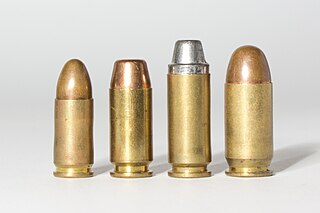
The 9×19mm Parabellum is a rimless, centerfire, tapered firearms cartridge.
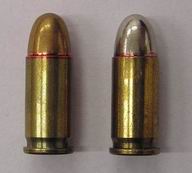
.32 ACP is a centerfire pistol cartridge. It is a semi-rimmed, straight-walled cartridge developed by firearms designer John Browning, initially for use in the FN M1900 semi-automatic pistol. It was introduced in 1899 by Fabrique Nationale, and is also known as the 7.65 mm Browning Short.
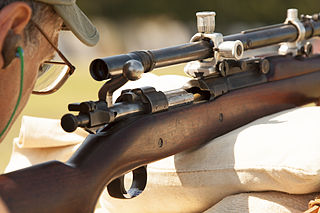
The chamber of a firearm is the cavity at the back end of a breechloading weapon's barrel or cylinder, where the ammunition is inserted before being fired. The rear opening of the chamber is the breech, and is sealed by the breechblock or the bolt.

The .22 Long Rifle, also known as the .22LR or 5.6×15mmR, is a long-established variety of .22 caliber rimfire ammunition originating from the United States. It is used in a wide range of firearms including rifles, pistols, revolvers, and submachine guns.

The 10mm Auto is a powerful and versatile semi-automatic pistol cartridge introduced in 1983. Its design was adopted and later produced by ammunition manufacturer FFV Norma AB of Åmotfors, Sweden.

The .44 Smith & Wesson Special, also commonly known as .44 S&W Special, .44 Special, .44 Spl, .44 Spc, or 10.9×29mmR, is a smokeless powder center fire metallic revolver cartridge developed by Smith & Wesson in 1907 as the standard chambering for their New Century revolver, introduced in 1908.
The .357 Maximum, formally known as the .357 Remington Maximum or the .357 Max, is a super magnum handgun cartridge originally developed by Elgin Gates as the wildcat .357 SuperMag. The .357 Maximum was introduced into commercial production as a joint-venture by Remington Arms Company and Ruger in 1983 as a new chambering for the Ruger Blackhawk. Shortly thereafter, Dan Wesson Firearms and Thompson/Center Arms introduced firearms in this cartridge. United Sporting Arms chambered it in their Silhouette series single-action revolvers. It is a .357 Magnum case lengthened 0.300 inches (7.6 mm). Based on the .357 Magnum cartridge, a revolver or single-shot pistol designed for the .357 Remington Maximum will chamber and fire the .360 Dan Wesson, .357 Magnum, .38 Special, .38 Long Colt, and .38 Short Colt cartridges. Intended primarily as a silhouette cartridge, such high velocity and energy levels have hunting applications. SAAMI pressure level for this cartridge is set at 40,000 pounds per square inch (280 MPa).

The .44-40 Winchester, also known as .44 Winchester, .44 WCF, and .44 Largo, was introduced in 1873 by the Winchester Repeating Arms Company. It was the first metallic centerfire cartridge manufactured by Winchester, and was promoted as the standard chambering for the new Winchester Model 1873 rifle. As both a rifle and a handgun caliber, the cartridge soon became widely popular, so much so that the Winchester Model 1873 rifle became known as "The gun that won the West."
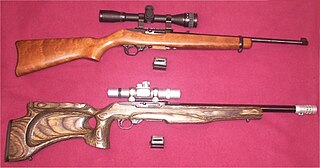
Firearm modification is commonly done in order to enhance various aspects of the performance of a firearm. Reasons for these modifications can range from cosmetic to functional, and can be simple operations that the owner can perform, or complex operations requiring the services of a gunsmith.

The .32 H&R Magnum, also known as the .32 Magnum, is a rimmed cartridge designed for use in revolvers. It was developed and introduced in 1984 as a joint venture between Harrington & Richardson and Federal Premium Ammunition.

A handgun is a firearm designed to be usable with only one hand. It is distinguished from a long gun which needs to be held by both hands and braced against the shoulder. Handguns have shorter effective ranges compared to long guns, and are much harder to shoot accurately. While most early handguns are single-shot pistols, the two most common types of handguns used in modern times are revolvers and semi-automatic pistols, although other handguns such as derringers and machine pistols also see infrequent usage.

The .41 Action Express is a pistol cartridge developed in 1986 to reproduce the performance of the .41 Magnum police load in semi-automatic pistols.
AB 1471 or AB 1471 Crime Gun Identification Act of 2007 is legislation passed by the California State Senate on September 6, 2007, and then by the California State Assembly on September 10, 2007, with votes of 21–17 and 43–29 respectively.
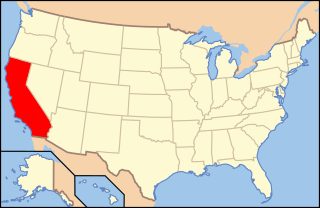
Gun laws in California regulate the sale, possession, and use of firearms and ammunition in the state of California in the United States.
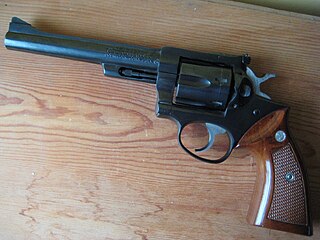
The Ruger Security-Six and its variants, the Service-Six and Speed-Six are a product line of double-action revolvers introduced in 1972 and manufactured until 1988 by Sturm, Ruger & Co. These revolvers were marketed to law enforcement duty issue, military, and civilian self-defense markets.

A gun serial number is a unique identifier assigned to a singular firearm.


















